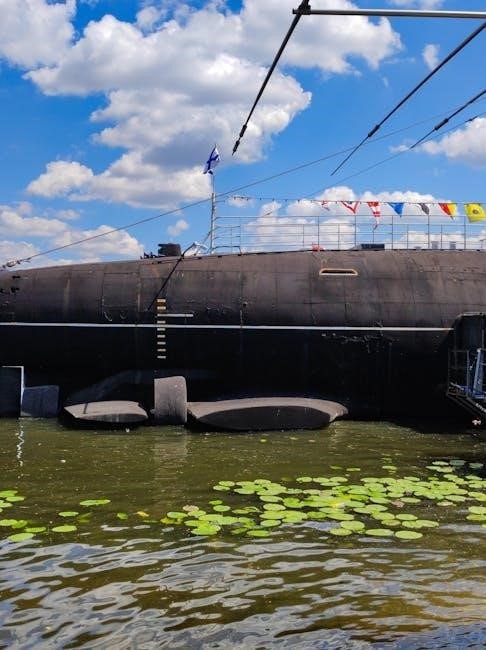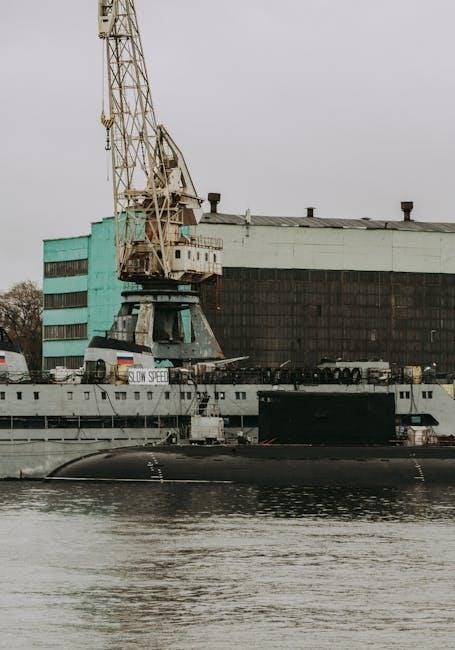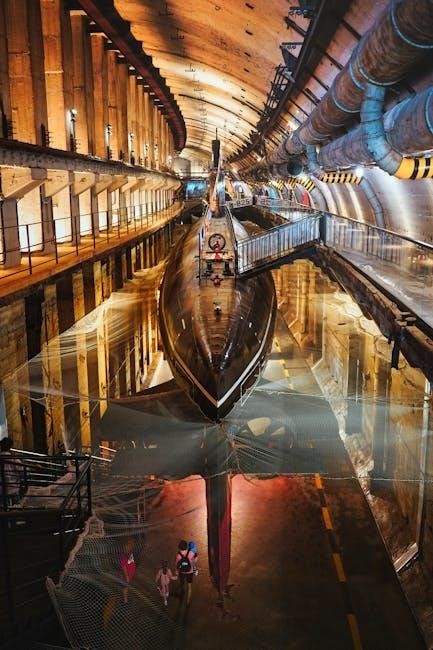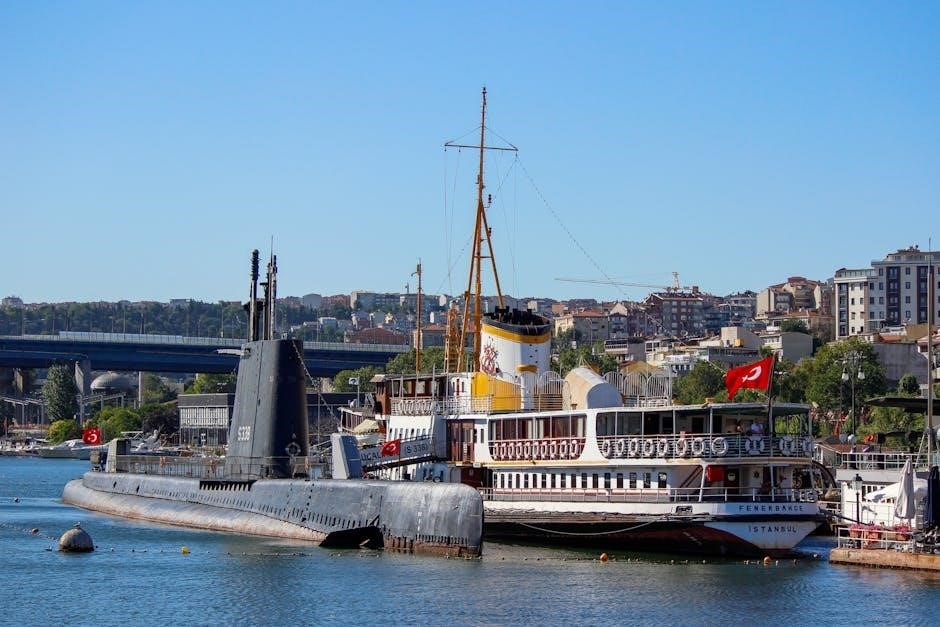The Russian Navy’s submarine fleet plays a crucial role in strategic deterrence and maritime power projection. Comprising nuclear and conventional submarines, it supports national security objectives amid evolving global challenges.

Overview of the Russian Navy Submarine Fleet
The Russian Navy operates a mixed fleet of nuclear and conventional submarines, totaling approximately 56 vessels. This includes Typhoon-class ballistic missile submarines and Improved Kilo-class diesel-electric submarines. The fleet has declined significantly since the Soviet era but remains a critical component of Russia’s naval capabilities, supporting strategic deterrence and regional security objectives.
Significance of Submarines in Russian Naval Strategy
Russian submarines are pivotal in projecting naval power, ensuring strategic deterrence, and safeguarding national interests. They enable the Navy to maintain a robust presence in key regions like the Baltic, North Atlantic, and Mediterranean, while supporting hybrid warfare capabilities and regional security objectives through advanced propulsion systems and missile technology.

History of Russian Navy Submarines
The Russian Navy’s submarine fleet has significantly decreased since the Soviet era, now operating around 56 submarines, down from 240, facing modernization and safety challenges.
Evolution from the Soviet Era to Modern Times
The Russian Navy’s submarine fleet has significantly reduced in size since the Soviet era, from 240 submarines to approximately 56 today. Despite this decline, modernization efforts continue, with a focus on maintaining nuclear and conventional capabilities. Challenges such as aging vessels and limited resources persist, while new projects like the Laika or Husky Class aim to revitalize the fleet for future strategic needs.
Key Milestones in Submarine Development
Russia’s submarine development has seen significant milestones, including the introduction of Typhoon-class submarines and the Bulava missile program. Improved Kilo-class submarines have enhanced stealth capabilities, while the Yasen-class redesign focuses on multirole functionality. These advancements reflect strategic adaptations to maintain naval competitiveness, despite the fleet reducing from 240 to 56 submarines since the Soviet era.
Classes of Russian Submarines
Russia operates a diverse fleet, including Typhoon-class ballistic submarines, Yasen-class multirole submarines, and Improved Kilo-class diesel-electric submarines, each tailored for strategic and tactical missions.
Nuclear-Powered Submarines
Russia’s nuclear-powered submarines form the backbone of its strategic deterrent and maritime power. Classes like the Typhoon, Borei, and Yasen are designed for ballistic missile, strategic, and multirole missions. These submarines are equipped with advanced propulsion systems, ensuring stealth and endurance. The Borei class, in particular, carries the Bulava SLBM, while the Yasen class excels in anti-submarine and anti-surface warfare. Modernization efforts continue to enhance their capabilities and operational range.
Conventional Diesel-Electric Submarines
Russia operates a fleet of conventional diesel-electric submarines, primarily the Improved Kilo Class, known for their stealth and reliability. These submarines excel in coastal defense and anti-submarine warfare. They are deployed in regions like the Baltic and Mediterranean, supporting regional security objectives. Modernization efforts focus on enhancing their combat systems and endurance, ensuring they remain effective in diverse operational scenarios while maintaining Russia’s export competitiveness in the global market.


Strategic and Tactical Roles
Russian submarines fulfill dual strategic and tactical roles, ensuring nuclear deterrence and conducting conventional missions. They are integral to maritime defense, power projection, and regional security operations globally.
Ballistic Missile Submarines (SSBNs)
Russian SSBNs, such as the Typhoon and Borei classes, are critical for strategic nuclear deterrence. Armed with SLBMs, they ensure a second-strike capability, maintaining global stability. Their operations are central to Russia’s national security strategy, providing an underwater nuclear deterrent and enhancing maritime presence in key regions like the North Atlantic and Mediterranean.
Attack Submarines (SSNs) and Cruise Missile Submarines (SSGs)
Russian attack submarines, including the Yasen and Akula classes, excel in anti-submarine and anti-ship missions, ensuring naval dominance. Cruise missile submarines like the Improved Kilo Class conduct land-attack missions, enhancing Russia’s multi-domain capabilities. These submarines operate in regions such as the Baltic and Mediterranean, demonstrating versatility and strategic reach.

Modernization and Developments
Russia is modernizing its submarine fleet with advanced propulsion systems and stealth technology, including new designs like the Laika-class submarines, to enhance strategic capabilities and operational effectiveness.
Current Modernization Efforts
Russia’s submarine modernization focuses on enhancing stealth, firepower, and endurance. Upgrades include advanced sonar systems, quieter propulsion, and integration of hypersonic missiles. The Yasen-class is being prioritized, with efforts to extend service life and improve combat readiness. These initiatives aim to maintain Russia’s strategic deterrent and ensure competitiveness in underwater warfare capabilities globally.
Future Submarine Projects (e.g., Laika or Husky Class)
Russia is developing the Laika and Husky-class submarines, focusing on advanced stealth, AI integration, and unmanned systems. These next-gen subs aim to blur lines between attack and strategic roles. Designed for multi-role operations, they incorporate cutting-edge technologies to counter emerging threats and maintain Russia’s naval dominance in future conflicts.

Operational Activities
Russian submarines engage in strategic deployments across the Baltic, North Atlantic, and Mediterranean. Recent exercises highlight their operational readiness, underscoring their role in maritime security and power projection.
Recent Deployments and Exercises
Russian submarines have been actively deployed in strategic regions, including the Baltic Sea and North Atlantic, showcasing their operational capabilities. Exercises such as Bastion drills demonstrate their readiness and coordination with surface fleets. These activities highlight Moscow’s commitment to maintaining a strong maritime presence and ensuring national security through continuous naval operations and modernized fleets.
Submarine Activity in Key Regions (e.g., Baltic, North Atlantic, Mediterranean)
Russian submarines are frequently observed in the Baltic Sea, North Atlantic, and Mediterranean. Their presence in these regions underscores strategic interests and operational readiness. Activities include patrols, exercises, and surveillance, reflecting Russia’s geopolitical priorities and its aim to project power in vital maritime areas, ensuring a robust naval presence aligned with national security objectives.

Challenges Facing the Russian Submarine Fleet
Russia’s submarine fleet faces declining numbers, maintenance challenges, and technological hurdles, impacting its operational readiness and strategic capabilities in an increasingly competitive maritime environment.
Declining Fleet Size and Maintenance Issues
Russia’s submarine fleet has significantly diminished since the Soviet era, dropping from 240 to approximately 56-58 submarines. Maintenance challenges, including aging vessels and resource constraints, further strain operational readiness. Issues like critical underspace leakage and extended shipyard periods highlight the struggle to sustain capabilities, impacting strategic deterrence and maritime security efforts.
Technological and Strategic Challenges
Russia’s submarine fleet faces technological gaps, particularly in advanced propulsion systems and stealth capabilities, lagging behind Western navies. Strategic challenges include adapting to shifting naval doctrines and countering emerging threats. Modernization efforts are hindered by resource limitations, impacting the fleet’s ability to maintain technological parity and operational effectiveness in an increasingly competitive maritime environment.

International Relations and Submarine Diplomacy
Russia strengthens ties through submarine exports and joint naval exercises, enhancing its global influence and strategic partnerships, particularly in regions like Cuba and the Mediterranean.
Submarine Exports and International Partnerships
Russia actively exports submarines to nations like India, China, and Algeria, enhancing its economic and strategic influence; These exports include advanced models such as the Akula and Yasen classes, strengthening Russia’s global naval presence and fostering diplomatic ties. Such partnerships underscore Russia’s role as a key player in the international submarine market, supporting its broader geopolitical objectives and military modernization efforts.
Regional Presence and Strategic Implications
Russia’s submarine presence in key regions like the Baltic, Mediterranean, and North Atlantic underscores its strategic influence. Deployments to Syria and visits to Cuba highlight Moscow’s efforts to project power and maintain alliances. These activities reinforce Russia’s role as a global naval power, ensuring its interests are protected while challenging the dominance of other maritime nations in contested areas.
Technological Advancements
Russia’s submarine fleet integrates advanced propulsion systems, enhancing stealth and efficiency. Investments in unmanned underwater vehicles and autonomous technologies bolster operational capabilities, ensuring competitiveness in modern naval warfare.
Advanced Propulsion Systems
Russia has developed cutting-edge propulsion systems, including air-independent and pump-jet technologies, significantly improving submarine stealth and endurance. These innovations enhance operational capabilities in strategic and tactical missions, ensuring the fleet remains competitive in modern naval warfare.
Unmanned Underwater Vehicles (UUVs) and Autonomous Systems
Russia is advancing its UUV capabilities, including the Poseidon nuclear-capable drone, to enhance underwater reconnaissance and strike abilities. Autonomous systems improve mission efficiency, enabling extended surveillance and mine countermeasures. These technologies bolster the Navy’s strategic and tactical operations, ensuring readiness for future maritime challenges.
Environmental and Safety Concerns
Russian submarine operations face challenges related to nuclear waste management and decommissioning of aging vessels, posing risks to marine ecosystems and requiring advanced safety protocols to mitigate environmental impact.
Nuclear Safety and Decommissioning Challenges
The Russian Navy faces significant challenges in ensuring nuclear safety and decommissioning its aging submarine fleet. The dismantlement of Northern Fleet submarines poses risks of nuclear accidents, with potential environmental and demographic consequences. Managing highly enriched uranium (HEU) and preventing reactor leaks remains critical. Decommissioning processes require advanced safety protocols to mitigate ecological and economic impacts, ensuring the secure handling of radioactive materials.
Environmental Impact of Submarine Operations

Russian submarine operations raise environmental concerns, particularly regarding underwater noise pollution and potential nuclear leaks. The presence of aging nuclear submarines increases the risk of ecological damage to marine ecosystems. Additionally, the disposal of radioactive waste from decommissioned vessels poses long-term threats to ocean health, necessitating stringent environmental regulations and safe disposal practices to mitigate these impacts effectively.
Future Outlook
Russia plans to modernize its submarine fleet, focusing on advanced technology and strategic capabilities, ensuring its naval presence remains robust in addressing future maritime challenges and goals.
Projected Growth and Modernization
Russia’s submarine fleet is expected to undergo significant modernization, with plans to develop advanced submarines like the Laika and Husky classes. These projects aim to enhance stealth, propulsion, and weaponry, ensuring the fleet remains competitive. Modernization efforts will focus on improving operational capabilities and extending the service life of existing vessels, addressing current technological and strategic gaps. This will help maintain Russia’s naval influence in key regions.
Strategic Shifts in Submarine Doctrine
Russia is adapting its submarine doctrine to address emerging security challenges, emphasizing multi-role capabilities and increased presence in strategic regions. The fleet is shifting focus towards enhancing its ability to conduct both conventional and nuclear deterrence missions. This doctrinal evolution reflects a broader effort to assert influence in global maritime theaters while countering potential threats from adversarial powers.
The Russian Navy’s submarine fleet remains a vital component of national defense, with ongoing modernization efforts aimed at enhancing its strategic capabilities and operational readiness.
The Russian Navy’s submarine fleet is a critical component of national defense, balancing nuclear deterrence and conventional capabilities. Modernization efforts focus on enhancing stealth, propulsion, and armament. Despite challenges like declining fleet size and maintenance issues, advancements in technology and strategic deployments ensure its continued relevance in global maritime security and power projection.
Final Thoughts on the Russian Navy Submarine Fleet
The Russian Navy’s submarine fleet remains a vital instrument of national power, balancing strategic deterrence with operational versatility. Despite challenges like declining numbers and maintenance issues, ongoing modernization and advancements in technology underscore its enduring relevance. Future projects, such as the Laika class, hint at a dynamic evolution, ensuring the fleet’s continued impact on global maritime security and geopolitical dynamics.



0 Comments